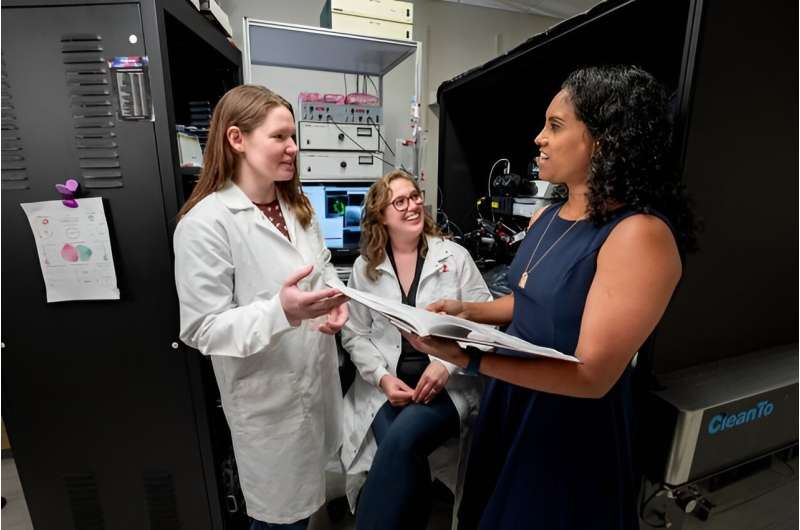The ability to study human neurological systems depends on having viable, accurate models of brain function. St. Jude researchers have now created a model for such research by combining thalamic cells and cortical cells derived from human induced pluripotent stem cells.
The thalamocortical system mediates multiple sensory and cognitive processes, such as perception, learning and memory. The researchers developed a model of a primitive human thalamocortical system by maintaining thalamic and cortical cell masses known as organoids in close proximity in a culture dish.
In this model, the neurons in both organoids develop and grow long-ranging processes (axons) that extend to the opposite organoid and form functional connections (synapses). The researchers determined that when these synapses are stimulated, they undergo long-term strengthening and weakening of their electrical signals, which is the hallmark of synaptic plasticity, a process that underlies certain forms of learning and memory.
The new human model was successfully validated against established animal models, demonstrating species differences in underlying mechanisms and emphasizing the importance of accurate human models. These findings were published this week in Cell Reports.
To study neuronal function in human models, scientists have historically relied on low-resolution methods that measure responses from a group of neurons, because high-resolution methods that measure single-cell or synaptic responses in humans were not available. St. Jude researchers wanted to address this.
“Our goal is to not only study neural circuits but also truly understand communication between neurons in the human brain,” said corresponding author Stanislav Zakharenko, MD, Ph.D., St. Jude Department of Developmental Neurobiology. “Therefore, we need to measure the activity between individual neurons at the sub-micron synaptic level.”
Studying synapses at the sub-micron level
Synaptic plasticity is based on the long-term strengthening and weakening of synapses as our brains develop and encode new information, but the minute scale at which this takes place means studying synapses in humans has been a long-standing dilemma in the field.
To address this, the researchers leveraged the recent surge in brain organoid research. “The technology has reached such a level where we can grow specific neurons, such as cortical or thalamic cells,” explained Zakharenko. “Once the cells are grown, they self-organize into a mass called an organoid and start to develop long-range processes (axons) with pre- and post-synaptic specializations.”
Researchers figured out that if two different types of organoids fuse together, they create an “assembloid” in which the two types of neurons continue to develop, send processes toward each other, and then begin to communicate.
However, for the researchers, that was only the first step. “We clumped thalamic and cortical cells together, and they began to self-organize and make connections,” Zakharenko explained. “But this could have just been a random, disorganized process. We needed to see if they could exhibit the synaptic plasticity characteristics of thalamocortical and corticothalamic synapses.”

Building an accurate model
A major hurdle in the organoid field has been selectivity. There are many types of neurons that communicate differently depending on the neurotransmitters they produce. The researchers utilized a cell culture system to select almost exclusively (>80%) neurons that communicate via the release of the neurotransmitter glutamate. This enabled the researchers to reliably measure synaptic plasticity using single-cell electrophysiological tools and high-resolution imaging.
Long-term strengthening and weakening of neuronal connections are traits of plasticity; as new bridges are formed, old ones need to be torn down. By monitoring the transmission of glutamate signaling, the researchers confirmed that the two different neurons were mirroring the behavior of the thalamocortical system in the human brain and, importantly, re-contextualizing what had been modeled before.
“We found that we could apply the same patterns of stimulation as have been applied to other animal models and the assembloids did the same thing, but with a slightly different mechanism,” Zakharenko emphasized.
While no single model system can tell a complete story, the addition of such organoids and assembloids to the neurological research toolkit is a boon for the field. The thalamocortical assembloid model, for example, carries huge potential in the study of neurological or psychiatric disorders.
“We know that thalamocortical deficits occur in schizophrenia, autism, and other psychiatric disorders, so in theory, we can extract cells from a patient or introduce a disease-causing mutation to healthy human cells and generate an assembloid model of a particular disease,” Zakharenko said. “With this model, we can then study synaptic plasticity as a consequence of the known mutation.”
More information:
Mary H. Patton et al, Synaptic plasticity in human thalamocortical assembloids, Cell Reports (2024). DOI: 10.1016/j.celrep.2024.114503
Citation:
Lab-grown human neuron assembloids effectively model synaptic plasticity (2024, July 19)
retrieved 19 July 2024
from https://medicalxpress.com/news/2024-07-lab-grown-human-neuron-assembloids.html
This document is subject to copyright. Apart from any fair dealing for the purpose of private study or research, no
part may be reproduced without the written permission. The content is provided for information purposes only.

